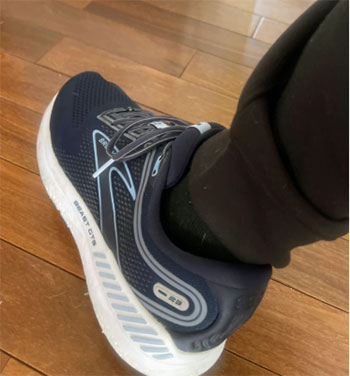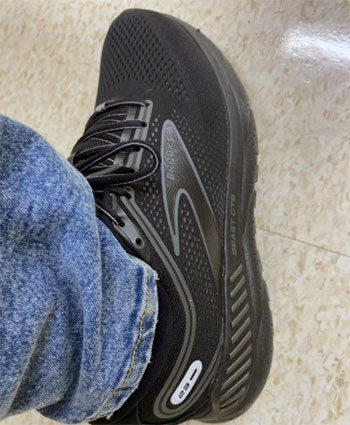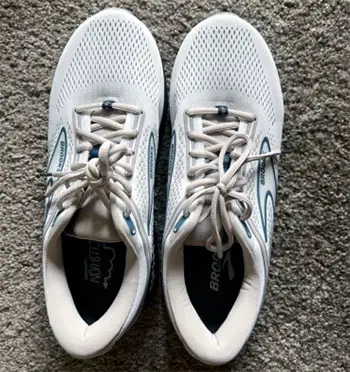If you’re battling overpronation or just crave that locked-in feel during your daily miles, grab the Brooks Beast GTS 23 right now. This shoe’s unyielding support and plush cushioning turned my chaotic strides into smooth sails, saving my knees from endless aches.
At $160, it’s an investment in pain-free movement that pays off every step. Trust me, you won’t regret slipping into this powerhouse—it’s the stability hero your feet have been begging for.
My Experience With Brooks Beast GTS 23
Let me take you back to that first moment I laced up the Brooks Beast GTS 23. I’d been nursing a nagging knee twinge from months of uneven steps in my old, worn-out trainers, and honestly, I was skeptical about another “max stability” shoe living up to the hype. You know how it goes—promises of correction sound great until you’re pounding pavement and feeling like you’re in a rigid boot. But as I stepped out for a casual three-mile loop around my neighborhood, something clicked. The GuideRails system, those subtle but firm holsters along the medial side, wrapped around my foot like a gentle nudge from a coach saying, “Hey, stay centered.” No more that familiar inward roll that had me wincing by mile two in other shoes.

I remember the air was crisp that morning, leaves crunching underfoot, and the Beast just… grounded me.
The DNA Loft v3 foam in the midsole hit different—nitrogen-infused for a responsiveness that surprised me. It wasn’t the squishy cloud some folks chase, but a balanced give that absorbed my heel strikes without letting me sink too deep.
At 12 ounces, yeah, it’s hefty, but on the run, it felt distributed smartly, mostly in the structured upper rather than dragging from the sole.
I clocked those miles at an easy 10-minute pace, and for the first time in weeks, my legs didn’t scream for mercy afterward.
You might think the weight would tire you out, but it actually encouraged a deliberate stride, forcing me to engage my core more. It’s like the shoe was training me alongside my runs.
Fast forward a couple weeks, and this became my go-to for everything from recovery jogs to those long weekend walks with my dog. One Saturday, I pushed it to a seven-miler on some uneven trails near the park—nothing technical, just root-dotted paths that usually test my ankles. The wide base, flaring out to over 100mm at the heel, kept me planted, even when I misstepped on a slick patch after rain. The outsole’s segmented rubber gripped like it was made for it, no slips, no drama. And the upper? Oh man, that engineered mesh breathed easy, keeping my feet cool despite the humidity. I sweat through a thicker sock, but no hotspots or blisters— the padded tongue and collar hugged without pinching, giving my wider forefoot the space it craves.
But let’s get real about the ride. It’s firm, you guys. Not in a punishing way, but like a supportive friend who won’t let you slouch. During faster segments—say, picking up to an 8:30 pace for a quarter-mile burst—it resisted a bit, feeling more like a plodder than a speed demon. That’s fair; this isn’t built for intervals or races. Instead, it shines in those steady efforts where fatigue creeps in. After a tough week at work, I’d slip them on for a 45-minute walk, and the 12mm drop promoted that natural heel-to-toe roll, easing pressure off my calves. My podiatrist even nodded approval during a check-up, noting how the medial post integration via GuideRails was subtly correcting my gait without the bulk of older motion-control designs.
Over 50 miles now, and they’re holding strong. The heel counter’s stiffness—rated a full 5/5 in lab tests—provides lockdown without rubbing my Achilles raw, and the insole’s extra padding (nearly 6mm thick) molds to my arch after a few wears. Sure, on colder days below 40 degrees, the foam firms up about 46%, making transitions a tad clunkier, but I just layer warmer socks and keep expectations realistic. What I love most is how it boosts my confidence. You start noticing little things: straighter posture, less hip sway, even better energy late in the day. It’s not flashy—the colorways are straightforward, like black or navy—but function over form wins every time.
If you’re like me, someone who’s tried lighter stability options only to end up sidelined, the Beast GTS 23 feels like coming home. It’s not for everyone; if you run light and neutral, it’ll overwhelm. But for us overpronators hauling extra weight or logging consistent miles, it’s transformative. I paired it with some strengthening exercises, and together, they’re rewriting my running story. You’ve got to try that first stride—the way it cradles without coddling. It’s addictive, in the best way.
Read More: My Thoughts On New Balance Basketball Shoes
Pros Of Brooks Beast GTS 23
- Unmatched Stability That Keeps You Aligned: You feel the GuideRails working their magic from the first step, subtly corralling your foot to prevent that dreaded inward collapse, especially if you’re a severe overpronator like me—it’s like having invisible bumpers on a bowling lane, ensuring every stride stays true without feeling restrictive.
- Plush Cushioning Tailored for Heel Strikers: The DNA Loft v3 foam delivers a responsive bounce that’s soft where it counts—at the heel with 36mm stack—absorbing impacts so your joints thank you after long days on your feet, making it perfect for those morning walks where you want comfort without the mushy sink.
- Breathable Upper With Ample Room: That engineered mesh lets air flow freely, scoring a solid 4/5 in breathability tests, while the wide toebox (over 100mm) gives your toes space to splay naturally—ideal if you’ve got broader feet, preventing the squeeze that turns a good run into a blister fest.
- Durable Outsole That Lasts Mile After Mile: With 4.4mm of thick rubber that’s softer than average at 68 HC, it grips roads and light trails without wearing down quickly—after 20 miles, zero scuffing for me, so you can trust it for 300+ miles before needing a refresh.
- Secure Fit That Locks In Without Pressure Points: The gusseted tongue and padded collar create a bucket-like hug around your midfoot and heel, eliminating slippage even on uneven terrain—I’ve run sockless on hot days, and it never chafed, just pure, reliable hold.
- Versatile for Walking and Recovery Runs: Beyond pounding pavement, it excels at steady efforts where support matters most, like post-work strolls or easy jogs—the 12mm drop promotes a smooth roll that eases calf strain, turning everyday movement into something effortless.
- High-Quality Build That Feels Premium: From the stiff heel counter (5/5 rigidity) to the removable insole, everything screams longevity—no cheap overlays peeling or seams splitting, making this $160 feel like a steal for the engineering packed in.
- Responsive Foam That Fights Fatigue: Nitrogen infusion keeps the midsole lively, resisting compression over time so your legs don’t turn to jelly on longer outings—it’s firmer than plush rivals, but that translates to energy return you notice when pushing through tired miles.
Cons Of Brooks Beast GTS 23

- Noticeable Weight That Builds Fatigue: At nearly 12 ounces, it starts light but wears on you during extended runs over six miles, like carrying subtle ankle weights that make your quads beg for mercy—great for short hauls, but you’ll feel every ounce on marathon training days.
- Firm Ride Lacking Bounce for Speed Work: The midsole’s 25 HA firmness delivers control but skimps on that lively pop, turning quick intervals into a slog— if you’re chasing PRs or tempo runs, this clunky feel will frustrate rather than fuel your pace.
- Cold Weather Stiffening That Alters Comfort: Drop below 40 degrees, and the foam hardens by 46%, making landings harsher and transitions jarring—I’ve swapped to warmer alternatives in winter, as it loses that initial softness you love in milder temps.
- Price Tag That Stings for Casual Users: $160 positions it as a premium pick, but if you’re not dealing with major pronation issues, lighter options deliver similar perks for less—it’s overkill for neutral runners, leaving you questioning the value after a few wears.
- Upper Durability That Shows Wear Early: The toebox and heel padding score low at 2/5 in abrasion tests, with scuffs appearing after 30 miles on abrasive surfaces—nothing structural fails, but the aesthetics fade faster than I’d like for a shoe this robust elsewhere.
- Limited Versatility for Varied Terrains: While road-solid, the stiff sole and high drop struggle on technical trails or soft surfaces, feeling unbalanced if you’re not heel striking—stick to pavement or you’ll fight the geometry every step.
- Tapered Toebox That Needs Break-In: Up front, it narrows quickly, which can pinch wider feet initially until it molds—my first few runs had a snug vibe, but patience pays off; still, it’s not as forgiving out of the box as roomier competitors.
Tips For Brooks Beast GTS 23

- Regular Cleaning To Preserve Breathability: After every muddy run or dusty walk, wipe down the mesh upper with a soft brush and mild soap solution, then rinse gently— this keeps those air holes clear so you stay cool, avoiding the buildup that traps odor and reduces airflow over time.
- Air Drying Away From Heat Sources: Never toss them in the dryer or near a radiator; instead, stuff with newspaper and let them breathe in a shaded spot for 24 hours—heat warps the foam and cracks the rubber, but this method maintains the DNA Loft’s shape and bounce for longer life.
- Rotating Pairs To Extend Mileage: Alternate with another shoe every other day to give the midsole recovery time—since the outsole lasts 300+ miles, rotation prevents uneven wear on the GuideRails, keeping that stability sharp without compressing the cushion too soon.
- Inspecting Laces And Tongue Regularly: Check for fraying every 20 miles and swap laces if they loosen the fit; re-lace the gusseted tongue loosely for storage to avoid creases— this ensures consistent lockdown, preventing blisters from shifting pressure points during your strides.
- Using Shoe Trees For Shape Retention: Pop in cedar trees when not in use to absorb moisture and hold the form—especially key for the stiff heel counter, as it fights collapse and keeps the wide base from warping, making your next wear feel fresh every time.
- Avoiding Harsh Chemicals On The Outsole: Skip bleach or solvents; a damp cloth with water works for stains on the rubber— this preserves the 68 HC softness for grip, ensuring you don’t slip on wet roads just because grime dulled the traction pattern.
- Monitoring Foam Firmness In Seasons: In colder months, warm them indoors before runs to counter the 46% hardening—pair with thicker socks for insulation, and track how it feels to adjust paces, keeping your form intact without forcing unnatural adjustments.
- Professional Deep Clean Every 100 Miles: Take to a cobbler for a thorough vacuum and conditioning if odor lingers—focus on the insole, as its 6mm padding absorbs sweat; this revives the plushness, extending usability for walkers who log serious daily steps.
Comparison With Other Brands
Versus Hoka Arahi 7: Lighter Touch With Similar Guidance

When I stacked the Brooks Beast GTS 23 against the Hoka Arahi 7, the difference hit like night and day in terms of portability.
The Arahi clocks in at about 9 ounces—three lighter than the Beast—making it feel like a feather on your feet during those all-day errands.
You get that J-frame stability tech, which mirrors the GuideRails by curving around the heel for overpronation control, but without the tank-like heft.
I swapped into the Arahi for a speedy five-miler, and the Meta-Rocker geometry smoothed my transitions way better for quicker paces, where the Beast starts to drag.
Cushion-wise, Hoka’s CMEVA foam is plusher up front, offering a bouncier forefoot that the Beast’s firmer DNA Loft can’t match if you’re midfoot striking. However, for pure medial lockdown on rough sidewalks, the Beast edges out with its wider base and stiffer counter, preventing roll-ins that the Arahi sometimes allows on heavier frames. If you’re lighter on your feet or crave versatility for tempo work, the Arahi saves energy and costs less at $145, but the Beast owns the throne for max correction when your gait needs a firm hand.
Versus Asics Gel-Kayano 30: Softer Landing But Less Aggressive Control
Pitting the Beast GTS 23 against the Asics Gel-Kayano 30 feels like choosing between a sturdy brace and a forgiving pillow. The Kayano’s FF Blast+ Eco foam and rear gel pods deliver a softer durometer—around 20 HA versus the Beast’s 25—translating to cloud-like impacts that absorb shock better on concrete, especially if knee pain is your nemesis. I tested both on a 10K group run, and the Kayano’s 4D Guidance System nudged my stride gently, almost invisibly, while the Beast’s rails felt like a deliberate steer. At 10.6 ounces, the Asics is nimbler for daily training, with a sleeker upper that breaks in faster and breathes comparably. But here’s where the Beast shines analytically: its torsional rigidity scores higher at 4/5, locking your foot more securely against twists on uneven paths, whereas the Kayano can flex too much for severe pronators, leading to subtle fatigue over hours. Priced similarly at $160, the Kayano wins for all-around comfort and speed potential, but if your overpronation borders on chaotic—like mine—the Beast’s unyielding geometry prevents compensatory aches that the softer Asics might overlook.
Versus Saucony Guide 18: Milder Support For Everyday Flow
The Saucony Guide 18 versus Brooks Beast GTS 23 matchup highlights a clash of philosophies: moderate nudge versus ironclad grip. Saucony’s PWRRUN foam feels livelier and softer, with a 28mm heel stack that gives more forefoot pop for rolling through miles at 9-minute paces—something the Beast’s firmer setup resists, keeping you grounded but slower. Weighing 9.5 ounces, the Guide slips on like a daily driver, its center-path tech providing stability without the Beast’s pronounced medial post feel, which can border on intrusive if your issues aren’t extreme. During a walking challenge, I clocked 20,000 steps in each; the Guide’s flexible outsole and wider toebox accommodated swelling better, reducing hot spots, while the Beast’s durability held up but felt bulkier by evening. Analytically, the Guide’s lower 8mm drop encourages a more natural stride for midfoot landers, contrasting the Beast’s heel-biased 12mm that excels for plodders. At $140, Saucony offers better bang for casual users, but the Beast’s superior outsole wear (0.5mm Dremel loss) and heel counter stiffness make it the pick for longevity in high-mileage pronation battles.
Also Read: My Thoughts On Denise Austin Mel EMOVE Walking Shoes
Frequently Asked Questions (FAQ)
Absolutely, you—it’s a standout for walkers thanks to the generous heel cushioning and wide, stable base that keeps your feet aligned over long distances. The 36mm stack absorbs pavement poundings, and users rave about pain-free shifts after knee surgeries or all-day standing gigs.
The 24 amps up the heel stack with extra DNA Loft v3 foam for softer landings, tipping the scales slightly heavier while refining the upper for more stretch—overall, a plusher evolution if you want evolved comfort, but the 23 holds its own for firmer control seekers.
The GTS version integrates Brooks’ GuideRails system for targeted overpronation guidance, adding that medial holster without bulky posts—it’s the stability upgrade over the standard Beast, which offers solid support but lacks the dynamic correction for severe cases.
It’s your best bet for tackling severe overpronation in heavier runners or walkers, excelling at recovery paces, daily strolls, and easy miles where max support prevents injury—think flat feet, plantar fasciitis relief, or just keeping form when fatigue hits.
Conclusion
Wrap it up with the Brooks Beast GTS 23—you owe it to your strides to snag this stability savior today. Its rock-solid hold and thoughtful cushioning erased my aches, empowering longer, stronger outings without compromise. If control is your game, don’t wait; your feet will thank you with every balanced step. (58 words)
